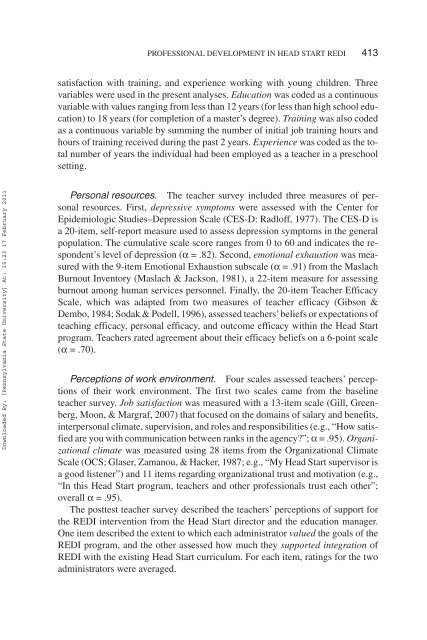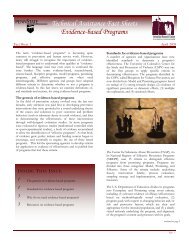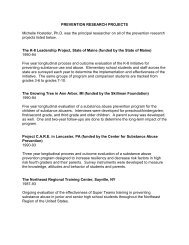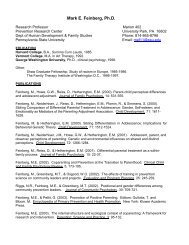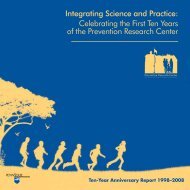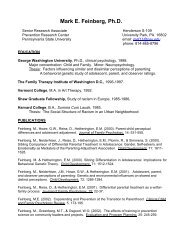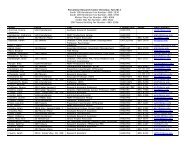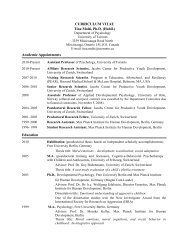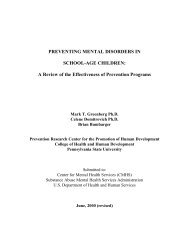Early Education & Development Individual Factors Associated With ...
Early Education & Development Individual Factors Associated With ...
Early Education & Development Individual Factors Associated With ...
Create successful ePaper yourself
Turn your PDF publications into a flip-book with our unique Google optimized e-Paper software.
PROFESSIONAL DEVELOPMENT IN HEAD START REDI 413<br />
satisfaction with training, and experience working with young children. Three<br />
variables were used in the present analyses. <strong>Education</strong> was coded as a continuous<br />
variable with values ranging from less than 12 years (for less than high school education)<br />
to 18 years (for completion of a master’s degree). Training was also coded<br />
as a continuous variable by summing the number of initial job training hours and<br />
hours of training received during the past 2 years. Experience was coded as the total<br />
number of years the individual had been employed as a teacher in a preschool<br />
setting.<br />
Downloaded By: [Pennsylvania State University] At: 15:23 17 February 2011<br />
Personal resources. The teacher survey included three measures of personal<br />
resources. First, depressive symptoms were assessed with the Center for<br />
Epidemiologic Studies–Depression Scale (CES-D: Radloff, 1977). The CES-D is<br />
a 20-item, self-report measure used to assess depression symptoms in the general<br />
population. The cumulative scale score ranges from 0 to 60 and indicates the respondent’s<br />
level of depression (α = .82). Second, emotional exhaustion was measured<br />
with the 9-item Emotional Exhaustion subscale (α = .91) from the Maslach<br />
Burnout Inventory (Maslach & Jackson, 1981), a 22-item measure for assessing<br />
burnout among human services personnel. Finally, the 20-item Teacher Efficacy<br />
Scale, which was adapted from two measures of teacher efficacy (Gibson &<br />
Dembo, 1984; Sodak & Podell, 1996), assessed teachers’beliefs or expectations of<br />
teaching efficacy, personal efficacy, and outcome efficacy within the Head Start<br />
program. Teachers rated agreement about their efficacy beliefs on a 6-point scale<br />
(α = .70).<br />
Perceptions of work environment. Four scales assessed teachers’ perceptions<br />
of their work environment. The first two scales came from the baseline<br />
teacher survey. Job satisfaction was measured with a 13-item scale (Gill, Greenberg,<br />
Moon, & Margraf, 2007) that focused on the domains of salary and benefits,<br />
interpersonal climate, supervision, and roles and responsibilities (e.g., “How satisfied<br />
are you with communication between ranks in the agency”; α = .95). Organizational<br />
climate was measured using 28 items from the Organizational Climate<br />
Scale (OCS; Glaser, Zamanou, & Hacker, 1987; e.g., “My Head Start supervisor is<br />
a good listener”) and 11 items regarding organizational trust and motivation (e.g.,<br />
“In this Head Start program, teachers and other professionals trust each other”;<br />
overall α = .95).<br />
The posttest teacher survey described the teachers’ perceptions of support for<br />
the REDI intervention from the Head Start director and the education manager.<br />
One item described the extent to which each administrator valued the goals of the<br />
REDI program, and the other assessed how much they supported integration of<br />
REDI with the existing Head Start curriculum. For each item, ratings for the two<br />
administrators were averaged.


